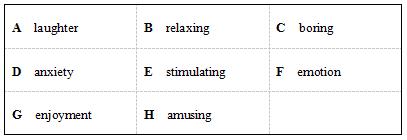摘要:今年6月初,《剑15》如约而至、作为国内雅思培训的领军机构,新航道也时间为考生们带来了这太《剑桥雅思真题全解15:学术类》(以下简称《剑15全解》)。在下文中小编整理了剑桥雅思15Test2阅读Passage3原文及翻译,希望对大家雅思考试有一定帮助。
每年年中左右,国内“雅思图”都要翘首期盼一件重要大事的来临:雅思真题的发布。无论是备考初期、后期,甚至已经考过雅思的学生,也无论是学生还是老师,都会密切关注新题的发布。今年6月初,《剑15》如约而至、作为国内雅思培训的领军机构,新航道也时间为考生们带来了这太《剑桥雅思真题全解15:学术类》(以下简称《剑15全解》)。
本次我们盛情邀请了新航道全国冬分校最的学科带头人来组织编写这本《剑15全解》。其中,对于以客观选择题为主的听力与阅读部分,仍然请各校团队进行解题思路方面的指导;对于以主观题为主的写作与口语部分,我们则邀请了官方认证考官撰写地道的高分范文,作为官方范文之外的补充。下文中详细整理了剑桥雅思15Test2阅读Passage3原文及翻译,一起来看一下吧!
剑桥15电子版本,请扫描二维码,暗号“优化+剑桥15全解”,会有老师联系并发送资料。

You should spend about 20 minutes on Questions 27-40, which are based on Reading Passage 3 below.
Having a laugh
The findings of psychological scientists reveal the importance of humour
Humans start developing a sense of humour as early as six weeks old, when babies begin to laugh and smile in response to stimuli. Laughter is universal across all human cultures and even exists in some form in rats, chimps, and bonobos. Like other human emotions and expressions, laughter and humour provide psychological scientists with rich resources for studying human psychology, ranging from the development of language to the neuroscience of social perception.
Theories focusing on the evolution of laughter point to it as an important adaptation for social communication. Take, for example, the recorded laughter in TV comedy shows. Back in 1950, US sound engineer Charley Douglass hated dealing with the unpredictable laughter of live audiences, so started recording his own 'laugh tracks'. These were intended to help people at home feel like they were in a social situation, such as a crowded theatre. Douglass even recorded various types of laughter, as well as mixtures of laughter from men, women, and children. In doing so, he picked up on a quality of laughter that is now interesting researchers: a simple 'haha' communicates a remarkable amount of socially relevant information.
In one study conducted in 2016, samples of laughter from pairs of English-speaking students were recorded at the University of California, Santa Cruz. A team made up of more than 30 psychological scientists, anthropologists, and biologists then played these recordings to listeners from 24 diverse societies, from indigenous tribes in New Guinea to city-dwellers in India and Europe. Participants were asked whether they thought the people laughing were friends or strangers. On average, the results were remarkably consistent: worldwide, people's guesses were correct approximately 60% of the time.
Researchers have also found that different types of laughter serve as codes to complex human social hierarchies. A team led by Christopher Oveis from the University of California, San Diego, found that high-status individuals had different laughs from low-status individuals, and that strangers' judgements of an individual's social status were influenced by the dominant or submissive quality of their laughter. In their study, 48 male college students were randomly assigned to groups of four, with each group composed of two low-status members, who had just joined their college fraternity group, and two high-status members, older students who had been active in the fraternity for at least two years. Laughter was recorded as each student took a turn at being teased by the others, involving the use of mildly insulting nicknames. Analysis revealed that, as expected, high-status individuals produced more dominant laughs and fewer submissive laughs relative to the low-status individuals. Meanwhile, low-status individuals were more likely to change their laughter based on their position of power; that is, the newcomers produced more dominant laughs when they were in the 4powerful5 role of teasers. Dominant laughter was higher in pitch, louder, and more variable in tone than submissive laughter.
A random group of volunteers then listened to an equal number of dominant and submissive laughs from both the high- and low-status individuals, and were asked to estimate the social status of the laugher. In line with predictions, laughers producing dominant laughs were perceived to be significantly higher in status than laughers producing submissive laughs. 'This was particularly true for low-status individuals, who were rated as significantly higher in status when displaying a dominant versus submissive laugh, ' Oveis and colleagues note. 'Thus, by strategically displaying more dominant laughter when the context allows, low-status individuals may achieve higher status in the eyes of others? However, high-status individuals were rated as high-status whether they produced their natural dominant laugh or tried to do a submissive one.
Another study, conducted by David Cheng and Lu Wang of Australian National University, was based on the hypothesis that humour might provide a respite from tedious situations in the workplace. This 'mental break5 might facilitate the replenishment of mental resources. To test this theory, the researchers recruited 74 business students, ostensibly for an experiment on perception. First, the students performed a tedious task in which they had to cross out every instance of the letter 'e' over two pages of text. The students then were randomly assigned to watch a video clip eliciting either humour, contentment, or neutral feelings. Some watched a clip of the BBC comedy Mr. Bean, others a relaxing scene with dolphins swimming in the ocean, and others a factual video about the management profession.
The students then completed a task requiring persistence in which they were asked to guess the potential performance of employees based on provided profiles, and were told that making 10 correct assessments in a row would lead to a win. However, the software was programmed such that it was nearly impossible to achieve 10 consecutive correct answers. Participants were allowed to quit the task at any point. Students who had watched the Mr. Bean video ended up spending significantly more time working on the task, making twice as many predictions as the other two groups.
Cheng and Wang then replicated these results in a second study, during which they had participants complete long multiplication questions by hand. Again, participants who watched the humorous video spent significantly more time working on this tedious task and completed more questions correctly than did the students in either of the other groups.
'Although humour has been found to help relieve stress and facilitate social relationships, the traditional view of task performance implies that individuals should avoid things such as humour that may distract them from the accomplishment of task goals/ Cheng and Wang conclude. 'We suggest that humour is not only enjoyable but more importantly, energizing.'
Questions 27-31
Choose the correct letter, A, B, C or D.
Write the correct letter in boxes 27-31 on your answer sheet.
23 When referring to laughter in the first paragraph, the writer emphasises
A its impact on language.
B its function in human culture.
C its value to scientific research.
D its universality in animal societies.
24 What does the writer suggest about Charley Douglass?
A He understood the importance of enjoying humour in a group setting.
B He believed that TV viewers at home needed to be told when to laugh.
C He wanted his shows to appeal to audiences across the social spectrum.
D He preferred shows where audiences were present in the recording studio.
25 What makes the Santa Cruz study particularly significant?
A the various different types of laughter that were studied
B the similar results produced by a wide range of cultures
C the number of different academic disciplines involved
D the many kinds of people whose laughter was recorded
26 Which of the following happened in the San Diego study?
A Some participants became very upset.
B Participants exchanged roles.
C Participants who had not met before became friends.
D Some participants were unable to laugh.
27 In the fifth paragraph, what did the results of the San Diego study suggest?
A It is clear whether a dominant laugh is produced by a high- or low-status person.
B Low-status individuals in a position of power will still produce submissive laughs.
C The submissive laughs of low- and high-status individuals are surprisingly similar.
D High-status individuals can always be identified by their way of laughing.
Questions 32-36
Complete the summary using the list of words, A-H, below.
Write the correct letter, A-H, in boxes 32-36 on your answer sheet.
The benefits of humour
In one study at Australian National University, randomly chosen groups of participants were shown one of three videos, each designed to generate a different kind of 32………….. . When all participants were then given a deliberately frustrating task to do, it was found that those who had watched the 33………….. video persisted with the task for longer and tried harder to accomplish the task than either of the other two groups.
A second study in which participants were asked to perform a particularly 34………….. task produced similar results. According to researchers David Cheng and Lu Wang, these findings suggest that humour not only reduces 35………….. and helps build social connections but it may also have a 36………….. effect on the body and mind.

Questions 37-40
Do the following statements agree with the claims of the writer in Reading Passage 3?
In boxes 37-40 on your answer sheet, write
YES if the statement agrees with the claims of the writer
NO if the statement contradicts the claims of the writer
NOT GIVEN if it is impossible to say what the writer thinks about this
37 Participants in the Santa Cruz study were more accurate at identifying the laughs of friends than those of strangers.
38 The researchers in the San Diego study were correct in their predictions regarding the behaviour of the high-status individuals.
39 The participants in the Australian National University study were given a fixed amount of time to complete the task focusing on employee profiles.
40 Cheng and Wang's conclusions were in line with established notions regarding task performance.
笑起来
心理学家的发现揭示了幽默的重要性
人类早在6周大的时候就开始有幽默感,这时婴儿会对刺激做出反应,他们开始大笑或微笑。笑在所有人类文化中都是普遍存在的,甚至还以某种形式存在于老鼠、黑猩猩和倭黑猩程身上。和其他人类情感和表情一样,笑声和幽默为心理学家从语言的发展到社会认知的神经科学的角度来研究人类心理学提供了丰富的资源。
专门研究笑声进化的理论表明,笑是一种为社会交流而发展出来的重要的适应性特征。以电视喜剧节目中录下来的笑声为例。早在1950年,美国录音师Charley Douglass 就讨厌面对现场观众不可预测的笑声,于是开始录制自己的“笑声音轨”。这是为了帮助居家的观众能感觉到仿佛处在社交场合,如济济一堂的剧院。除了录制男性、女性及儿童的混合笑声,Douglass甚至还录下了不同类型的笑声。就这样,他注意到了笑声的一种特性,这一特性现在引起了研究人员的注意:一个简单的“哈哈”可以传达大量的社会相关信息。
在2016年进行的一项研究中,加州大学圣克鲁斯分校录制了一些讲英语的学生的笑声样本。一个由30多名心理学家、人类学家和生物学家组成的研究小组随后将这些录音播放给来自24个不同社会群体的听众,这些群体包括新几内亚的土著部落、印度和欧洲的城市居民。参与者回答他们认为笑的人是朋友还是陌生人。平均来看,结果出奇地一致:世界各地人们的猜测大约有60%是正确的。
研究人员还发现,不同类型的笑声隐藏着复杂的人类社会阶层的信息。加州大学圣地亚哥分校的 Christopher Oveis 领导的一个研究小组发现,社会地位高的人和社会地位低的人笑得不一样,而且陌生人对一个人社会地位的判断会受到其笑声的支配性或顺从性的影响。在他们的研究中,48名男大学生被随机分配,四人一组,每组由两名社会地位低的成员和两名社会地位高的成员组成,地位低者刚刚加入大学兄弟会,而地位高的成员则是至少在兄弟会活跃了两年的年长学生。当每个学生轮流被其他人取笑时,包括使用稍有侮辱性的绰号,他们的笑声被录制了下来。分析显示,正如设想的那样,与地位低的人相比,地位高的人会发出更多支配性的笑声、更少顺从性的笑声。同时,地位低的人更有可能根据自己的权力地位改变笑声;也就是说,当新来者扮演“有权威的”取笑者角色时,他们的笑声更具有支配性。支配性的笑声比顺从性的笑声在音调上更高、更大声、更多变。
然后,研究者随机挑选了一组志愿者,让他们听同等数量的地位高的人和地位低的人,分别发出的支配性笑声和顺从性笑声,并判断发笑的人的社会地位。与预测一致的是,发出支配性笑声的人被认为比发出顺从性笑声的人地位要高得多。Oveis和他的同事们指出:“对于地位较低的人来说尤其如此,当他们展现出一种支配性的笑而不是顺从性的笑时,他们被认为的地位就会明显提高。因此,在环境允许的情况下,通过有意地表现出更有支配性的笑容,地位较低的人可能会在别人眼中获得更高的地位。”然而,地位高的人无论他们是自然地发出支配性的笑声,还是试图发出顺从性的笑声,都被认为是地位高的。
澳大利亚国立大学的David Cheng和Lu Wang进行的另一项研究的基础是,设想幽默感可以在枯燥的工作环境中起到缓解作用。这种“脑力休息”可能会有益于补充脑力。为了验证这一理论,研究人员招募了74名商科学生,表面上是为了进行一项关于感知的实题。首先,学生们完成了一项冗长乏味的任务,他们必须在两页书上划掉所有字母e。接着,这些学生被随机分配观看一段视频,有的可以激发幽默,有的可以激发满足感,还有的是不涉及感情的视频。有些人看的是一段BBC的喜剧《憨豆先生》,有些人看的是海豚在海里游泳的轻松场景,还有一些人看的是关于管理职业的实景视频。
然后,学生们去完成一项要求耐力的任务,他们要根据所给的个人档案猜测员工的潜在表现,并被告知连续做对10个正确的评估将会获胜。然而,软件的设置使得几乎不可能连续猜对10个正确答案。参与者可以在任何时候退出任务。观看了《憨豆先生》视频的学生最终花了更多的时间完成任务,做出预测的次数是另外两组的两倍。
然后,Cheng和Wang在第二项研究中得出了同样的结果。在第二项研究中,他们让参与者徒手完成长式子乘法运算。同样,那些看了幽默视频的参与者比其他两组的学生花了更多的时间在这个枯燥的任务上,并且正确完成的问题也更多。
Cheng和Wang得出结论:“尽管研究发现,幽默有助于缓解压力、缓和社会关系,但关于任务表现的传统观点表明,人们应该避免幽默等可能分散他们完成任务目标的事情而我们认为,幽默不仅让人愉快,更重要的是能让人精力充沛。”
免费领取最新剑桥雅思、TPO、SAT真题、百人留学备考群,名师答疑,助教监督,分享最新资讯,领取独家资料。
方法1:扫码添加新航道老师

微信号:shnc_2018
方法2:留下表单信息,老师会及时与您联系
| 课程名称 | 班级人数 | 课时 | 学费 | 报名 |
|---|---|---|---|---|
| 雅思入门段(A段)6-10人班 | 6-10人 | 80课时 | ¥18800 | 在线咨询 |
| 雅思冲刺段(C段)6-10人班 | 6-10人 | 72课时 | ¥26800 | 在线咨询 |
| 雅思全程段(B+C段)6-10人班 | 6-10人 | 192课时 | ¥45800 | 在线咨询 |
| 雅思精讲段(B段)6-10人班 | 6-10人 | 96课时 | ¥25800 | 在线咨询 |
| 雅思口语单项班 | 15-20人 | 按需定制 | ¥ | 在线咨询 |
| 课程名称 | 班级人数 | 课时 | 学费 | 报名 |
|---|---|---|---|---|
| 雅思强化段(C段)20-30人班 | 20-30人 | 96课时 | ¥8800 | 在线咨询 |
| 雅思精讲段(B段)20-30人班 | 20-30人 | 96课时 | ¥7800 | 在线咨询 |
| 雅思全程班(B+C段)20-30人班 | 20-30人 | 192课时 | ¥13800 | 在线咨询 |
| 课程名称 | 班级人数 | 课时 | 学费 | 报名 |
|---|---|---|---|---|
| 雅思强化段(C段)6-10人班住宿班 | 6-10人 | 152 | ¥28800 | 在线咨询 |
| 雅思全程班(A+B+C段)6-10人班住宿 | 6-10人 | 304课时 | ¥50800 | 在线咨询 |
| 雅思精讲段(B段)6-10人班住宿班 | 6-10人 | 152课时 | ¥29800 | 在线咨询 |
| 雅思入门段(A段)6-10人班(住宿) | 6-10人 | 80课时 | ¥20800 | 在线咨询 |
| 雅思3周特训住宿班 | 10 | 228 | ¥30800 | 在线咨询 |
| 课程名称 | 班级人数 | 课时 | 学费 | 报名 |
|---|---|---|---|---|
| 雅思强化段(C段)20-30人班住宿班 | 20-30人 | 96课时 | ¥8800 | 在线咨询 |
| 雅思全程段(A+B+C段)20-30人班住宿 | 20-30人 | 192课时 | ¥15800 | 在线咨询 |
| 雅思精讲段(B段)20-30人班住宿班 | 20-30人 | 96课时 | ¥9800 | 在线咨询 |
| 课程名称 | 班级人数 | 课时 | 学费 | 报名 |
|---|---|---|---|---|
| 雅思一对一 | 1人 | 按需定制 | ¥980元 | 在线咨询 |
| 雅思托福预备班 | 6-10人 | 50 | ¥9800 | 在线咨询 |
| 雅思免费试听课 | 不限 | ¥0元 | 在线咨询 | |
| 雅思口语5月新题刷题实战营 | ¥999 | 在线咨询 |
热门搜索: 上海雅思培训 上海雅思培训机构哪家好 上海雅思封闭班 上海雅思1对1培训 上海雅思培训
免责声明
1、如转载本网原创文章,请表明出处;
2、本网转载媒体稿件旨在传播更多有益信息,并不代表同意该观点,本网不承担稿件侵权行为的连带责任;
3、如本网转载稿、资料分享涉及版权等问题,请作者见稿后速与新航道联系(电话:021-64380066),我们会第一时间删除。
地址:徐汇区文定路209号宝地文定商务中心1楼
乘车路线:地铁1/4号线上海体育馆、3/9号线宜山路站、11号线上海游泳馆站
总部地址:北京市海淀区中关村大街28-1号6层601 集团客服电话:400-097-9266 总部:北京新航道教育文化发展有限责任公司
Copyright © www.xhd.cn All Rights Reserved 京ICP备05069206


 微信公众号
微信公众号
 微信社群
微信社群